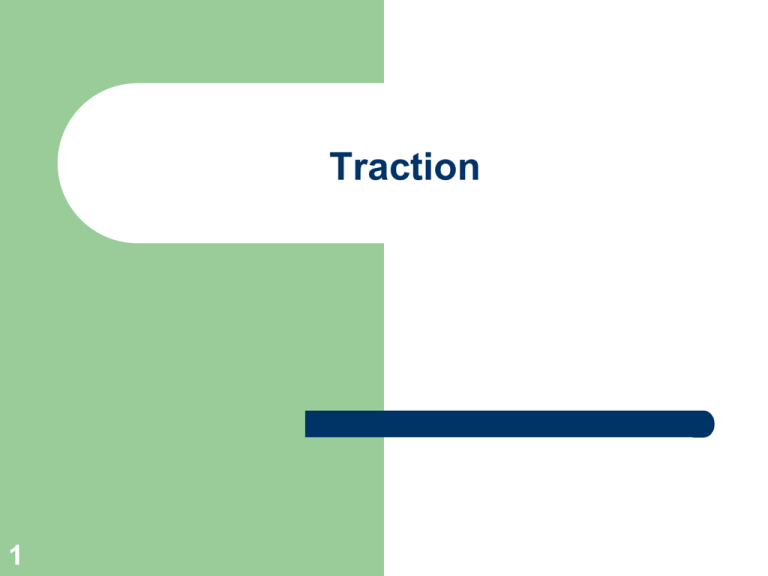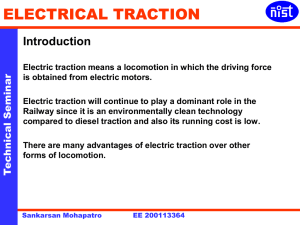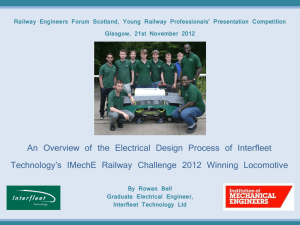Traction - Faculty
advertisement

Traction 1 Effects of Spinal Distraction 2 Joint Distraction – Separation of two articular surfaces – Can treat facet joint & spinal nerve root symptoms – Distraction force 50% of BW for Lspine & 7% for Cspine Effects of Spinal Distraction Reduction of Disc Protrusion – – 3 Suction due to decreased intradiscal pressure Force of 60-120 #’s have been shown to reduce lumbar disc protrusion Effects of Spinal Distraction Soft Tissue Stretching – – 4 Muscles, tendons, ligaments, discs Increase soft tissue length & increase joint mobility Effects of Spinal Distraction 5 Muscle Relaxation – Can facilitate muscle relaxation May be due to reduction of pain May be due to prolonged stretch (may fire the GTO) Effects of Spinal Distraction Joint Mobilization – 6 Stretching of soft tissues with traction can increase joint mobility Effects of Spinal Distraction Patient Immobilization – – 7 Very low-load traction (10-20 #’s) has been used to immobilization pts with spinal disorders (Bucks Traction) Presently, not as popular Clinical Indications for the Use of Spinal Traction Disc Bulge or Herniation – – 8 Traction may be more beneficial for disc bulge than herniation The greater the damage to the disc, the less effective traction may be. Clinical Indications for the Use of Spinal Traction 9 Nerve Root Impingement Clinical Indications for the Use of Spinal Traction Joint Hypomobility – – 10 Traction cannot isolate a local area of hypomobility Traction can improve mobility throughout the treated area (c-spine, l-spine) Clinical Indications for the Use of Spinal Traction Subacute Joint Inflammation – 11 Traction may reduce strain on injured tissues &/or joints Clinical Indications for the Use of Spinal Traction Paraspinal Muscle Spasm – 12 Can reduce muscle spasm by reducing by &/or firing the GTO Clinical Indications for the Use of Spinal Traction 13 Contraindications for the Use of Traction Where motion is contraindicated – 14 Example – unstable fracture, spinal cord compression, or shortly after spinal surgery Contraindications for the Use of Traction With an acute injury or inflammation – 15 Example – shortly after trauma, surgery, RA, OA Contraindications for the Use of Traction Joint hypermobility or instability – 16 Example – fractures, dislocation, surgery, pregnancy, lactation, RA, Down’s syndrome Contraindications for the Use of Traction 17 Peripheralization of symptoms with traction Contraindications for the Use of Traction 18 Uncontrolled hypertension (for inversion traction) Precautions for the Use of Traction 19 Structural diseases or conditions affecting the spine(tumor, infection, rheumatoid arthritis, osteoporosis, or prolonged systemic steroid use) Precautions for the Use of Traction 20 When pressure of the belts may be hazardous (pregnancy, hernia, vascular compromise, osteoporosis) Precautions for the Use of Traction Displacement of annular fragment – 21 Traction is not likely to change the position of the fragment Precautions for the Use of Traction Severe pain relieved by traction – 22 May indicate the spinal nerve root becoming more compressed as a result of the traction intervention Precautions for the Use of Traction 23 Claustrophobia Precautions for the Use of Traction 24 Patients who cannot tolerate the prone or supine position – Pain in prone or supine position or acid reflux Precautions for the Use of Traction 25 Disorientation Precautions for the Use of Traction 26 Temporomandibular joint (TMJ) problems and dentures 27 Adverse Effects of Spinal Traction 28 Worsening of symptoms New symptoms (radiculopathy due to excessive strain on the spinal cord dura) Application Technique: Mechanical Traction 29 Mechanical Lumbar Traction Procedure Application Technique: Mechanical Traction 30 Mechanical Cervical Traction Procedure Application Techniques: SelfTraction Examples of SelfTraction – – – 31 Sitting Self-Traction Self-Traction Between Corner Counters Self-Traction With Overhead Bar Application Techniques: Positional Lumbar Traction 32 Application Techniques: Manual Traction 33 Traction 34 MRI results before and after cervical traction VAX-D 35 VAX-D 36 37 38 39 40 Sari et al. Computed tomographic evaluation of lumbar spinal structures during traction. Physiother Theory Pract. 2005 JanMar;21(1):3-11. 41 42 43








